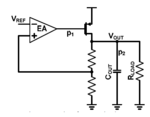lovaraju.ch
Newbie level 6
Dear all,
I am designing a low dropout regulator for 1 mA to 100 mA of load current. when the load current is 1 mA the pass transistor (pmos) is going into the subthreshold region and due to this, overshoot and undershoot are increased . so could you please tell me how to avoid subthreshold operation of pass transistor at 1 mA of load current.
waiting for your valueble reply
thanks...
I am designing a low dropout regulator for 1 mA to 100 mA of load current. when the load current is 1 mA the pass transistor (pmos) is going into the subthreshold region and due to this, overshoot and undershoot are increased . so could you please tell me how to avoid subthreshold operation of pass transistor at 1 mA of load current.
waiting for your valueble reply
thanks...


